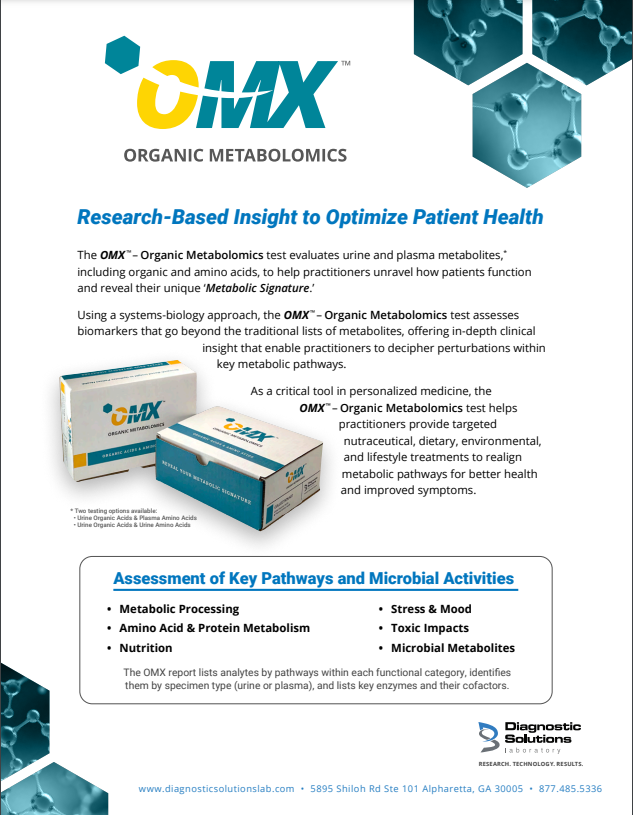OMX | Organic Metabolomics
Advanced Organic Acids and Amino Acids Profile

OMX SCIENCE & TECHNOLOGY
The OMX Organic Metabolomics test evaluates urine metabolites—including organic acids, amino acids, and other key compounds—to assist practitioners in unravelling their patient’s metabolic pathways, revealing their unique Metabolic Signatures.
Revealing Your Patient’s Metabolic Signature
What is Metabolomics Testing?
Metabolomics, also called comprehensive metabolic profiling, evaluates patterns of metabolites related to core biological systems, offering insight into biochemical dysfunctions that may be of concern.
Organic acids and other small molecules are intermediate compounds that can define the efficient flow of pathways and substrates such as amino acids to reveal the level of inputs, which together establish the functional status of key areas of health.
Metabolites are impacted by many factors and can change in response to diet, nutrient status, toxin exposures, exercise, physiologic demands, genetics, gut microbiome alterations, or disease stage.
While combining assessment of all of the above, metabolic analysis can help clinicians evaluate the function of key pathways to better target support.
OMX Testing Methodologies Backed by Science:
The metabolome is a measure of the inputs and outputs of biological pathways and, as such, is often considered more representative of the functional state of a cell than other ‘omics measures such as genomics or proteomics.
National Institute of Health
The OMX metabolomics test algorithms are based on published literature. Results offer actionable information practitioners can use to develop personalised interventions.
Using a systems-biology approach, OMX assesses biomarkers that go beyond the traditional lists of metabolites. The OMX test enables practitioners to see a patient’s larger health picture by deciphering and connecting perturbations of key metabolic pathways and analytes, allowing for truly personalised therapeutic support.
OMX Organic Metabolomics...
Identify Metabolomic Deviations on an Individual Level
OMX metabolomic testing goes beyond traditional organic acid testing. OMX characterises metabolic phenotypes by presenting analytes in pathway categories to more easily identify metabolomic deviations that can underlie—and even precede—disease.
OMX also offers additional key markers and ratios as a standard part of the profile, including cortisol, kynurenine, microalbumin, equol, and more.
The Designs for Health in-house interpretation sessions can explain more.
OMX Tests - Urine Analytes Grouped Into Six Functionally Related Categories:
- Metabolic Processing
- Amino Acid & Protein Metabolism
- Nutrition Status
- Stress & Mood
- Microbial Metabolites (assessing large scale dysbiosis)
- Toxic Impacts
The first page of the OMX report provides an overview of impairments for each functional category practitioners can use to easily review results with patients. This page includes useful charts, including a convenient “Health Target” graphic that can help patients immediately start to recognise their current metabolic signature.
The bulk of the multi-page report details every analyte detected, along with the enzymes that affect a patient’s metabolic pathways. Customised treatment recommendations are also conveniently provided on the last page of the report. See the OMX Sample Report for more details.

OMX Metabolomics Course
Gain in-depth knowledge to evaluate and interpret the OMX Test.
References
- U.S. Department of Health and Human Services. (2016, March 9). Metabolomics Overview. National Institutes of Health. Retrieved November 23, 2021
- Hood, L. as cited in Miller, I.J., Peters, S.R., Overmyer, K.A. et al. Real-time health monitoring through urine metabolomics. npj Digit. Med. 2, 109 (2019).
- Beger RD, Dunn W, Schmidt MA, et al. Metabolomics enables precision medicine: “A White Paper, Community Perspective”. Metabolomics. 2016;12(10):149.


